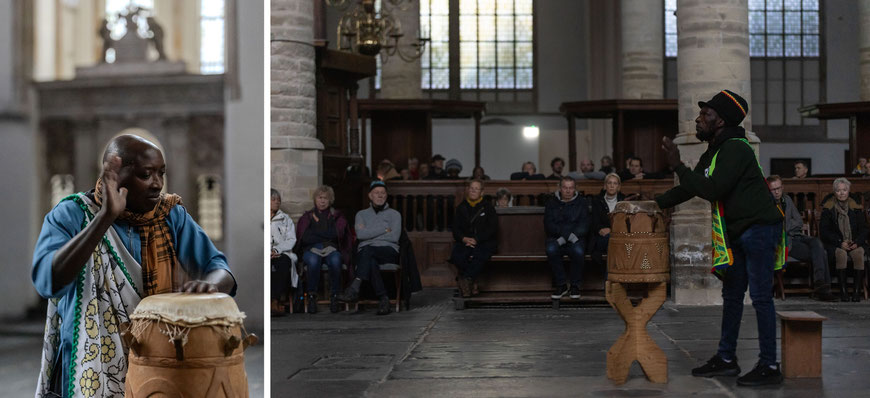Call and response for talking drum and organ tongue
(2023) Oude kerk, Amsterdam
Edje Doekoe (apinti drum), Marjet Zwaans, Vinije Haabo
in collaboration with Jose Tojo (apinti) and Ana Guedes (organ)
3 november 2023 | 08.00-09.00
curated by Marianna van der Zwaag
photos Maarten Nauw







Ancient musical traditions and sound worlds come together in this new edition of morning series Silence. The apintidrums and church organs emerge from different contexts of cultural expression
and musical traditions. Improvisationally, the instruments respond to each other. There are no fixed seats; visitors are invited to walk around and discover how the music sounds in different
places in the church.
The apinti is a drum language used in maroon communities in Suriname to communicate between people, the natural world and the spiritual world. Among other things, the apinti drum is used to
exchange important messages between communities, ministers are accompanied by it during journeys and village meetings are opened with it.
The apintidrum brought from Africa and its accompanying language are considered sacred and is inspired by the wisdom of nature. The organ is connected to the structure, the architecture functioning as a sound box. Throughout history, church organs have sounded both folk melodies and psalms. The organ and apintidrum function in different contexts, yet both are part of a religious, political and economic story that is historically intertwined.
Edje Doekoe (apintidrum)
Edje Doekoe was born and raised in Pikin Slee, a village in Suriname. He is one of the few men who did not have to leave the village for a period of work in the coastal areas of Suriname or
French Guiana. A follower of the Rastafari faith in the 1980s, he rebelled against the system at a young age. It was necessary to (re)learn to live better with nature was the conviction. After
wandering through the forest for two years, he was allowed to participate in village activities again on a small scale, culminating in Edje Doekoe being appointed Basia in 2008. From this role,
he further immerses himself in Apinti, to pass it on to the next generation. He is an important drummer in village affairs.
Jose Tojo (apintidrum)
Jose" Joseph" Tojo was born and partly raised in the interior of Suriname as a Paramaccan maroon and son of a master drummer who was the apintiman of the grand chief of the Paramaccaners. Jose
was trained as a drummer by his father. In 1990, he became artistic director of the Kifoko Social Cultural Association founded by Andre Mosis with the motto "Kifoko is a school". With Kifoko, he
specialised in folk theatre, singing, dancing and percussion. In 2001, he left for the Netherlands to do the International Theatre School, Its DNA, in Amsterdam. Coupled with this, he did a year
at the Hogeschool voor de Kunsten in Amsterdam to improve his transfer techniques. Since then, Jose Tojo has worked as an actor, director, drummer and choreographer.
Ana Guedes (organ)
Ana Guedes is a Portuguese-born multidisciplinary artist living and working in the Netherlands. Her artistic practice combines media such as sound, video, installation and performance. She
followed a residency programme at the Jan van Van Eyck Academy in Maastricht and did a master's in Artistic Research at the Royal Conservatoire in The Hague and the Royal Academy of Arts in the
same city. In 2021, Guedes developed a sound installation especially for the Oude Kerk. Read more about the work here. Furthermore, Guedes
showed her work at Stroom Den Haag, De Fabriek in Eindhoven and Museo Reina Sofía in Madrid, among others. This Silence edition is part of an ongoing investigation into the possibilities
of sonic mapping.
Totomboti, Vinije Haabo and Marjet Zwaans
The idea for this Silence arose from conversations about long-term cooperation and coordination within artist collective Totomboti. For this particular Silence concert at the Oude Kerk, between
Edje Doekoe, Vinije Haabo and Marjet Zwaans. "We talk and work with each other in a manners where we mutually contribute and can benefit from the knowledge of ancestors from the Netherlands and
from the interior of Suriname." This concert fits within their current ongoing research Kanda Hanka, Songs Anchoring. In June 2024, they will present this research at Oerol
Terschelling.
Artist collective Totomboti is known for its massive carvings inspired by the obia and other natural phenomena. In doing so, they continue the tradition of their African ancestors who fled
slavery in coastal areas to settle in the deep interior of Suriname since the 17th century. The collective has its roots in the Rastafarian movement of the early 1980s. The Rastas propagate an
attitude to life aimed at preserving nature and Saramakan cultural heritage. The Saamaka Museum was founded in 2009 by the men of Totomboti. The collective consists of Toya Saakie, Etyo Doekoe,
Mando Doekoe, Wilko Doekoe, Abentini Doekoe.
Vinije Haabo (Pikin Slee, 1971) is a linguist, born in Suriname and a descendant of the Saramakaners, one of Suriname's Maroons. He studied International Development Studies and African
Linguistics and has lived in Wageningen since 2002. Vinije is a writer, journalist, project coordinator and linguistic researcher. He also had a crucial role in the making of VPRO youth
documentary Kinderen van Mavungu, about children in the Surinamese interior. He is currently completing his life's work to date: The Great Dictionary of the Saramakan Language.
Marjet Zwaans (born 1988) is an artist living and working in Amsterdam and Pikin Slee, Suriname. She studied Fine Arts at the Academie Minerva in Groningen. She organises her work from the ideas
of Ecological Economics and arranges them into spatial installations, vocal performances and gatherings. Zwaans was a resident at the Jan van Eyck Academy in 2019-2020. Within her artistic
practice, she is active in two artist collectives: CUPP collective (founded in 2020 together with artist Razia Barsatie) and Totomboti.
